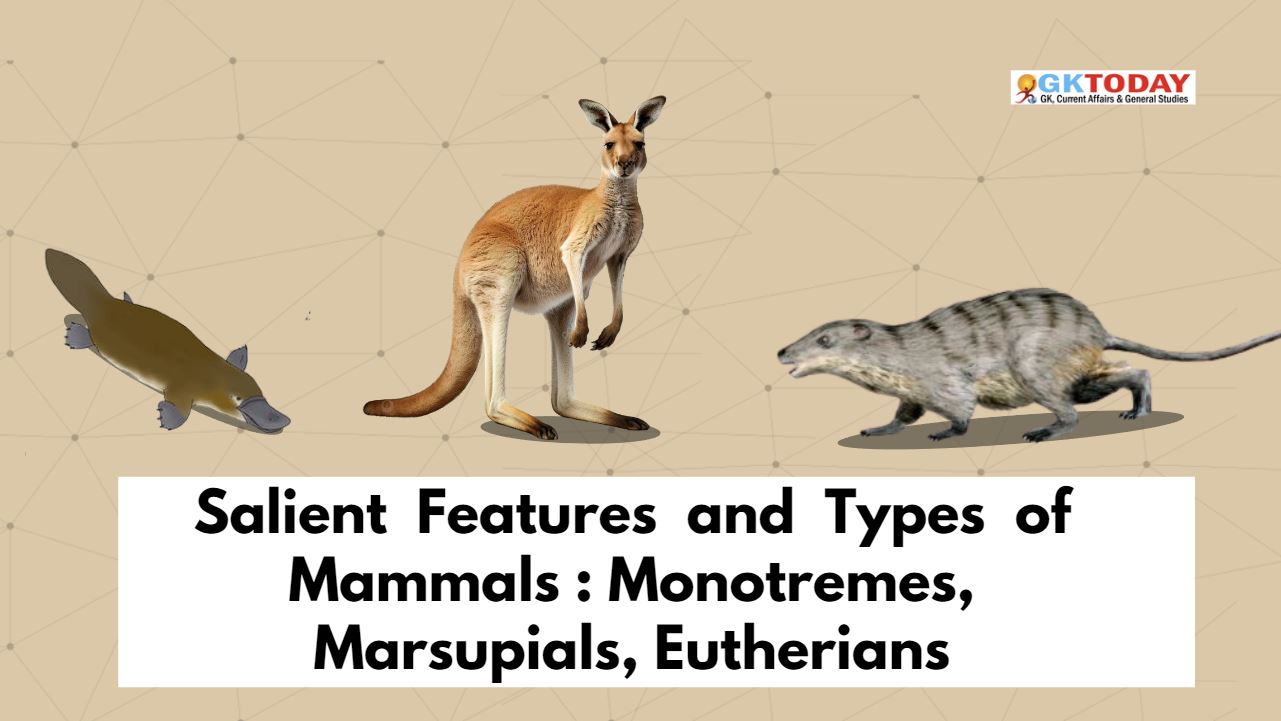Salient Features and Types of Mammals: Monotremes, Marsupials, Eutherians
Both birds and mammals have evolved from a reptile ancestor. In terms of evolution, mammals are most advanced organisms found in almost all habitats in Earth’s biosphere including polar ice caps, deserts, mountains, forests, grasslands and dark caves.
Common features of all mammals
All mammals have six things in common. Firstly, all mammals are vertebrates and have a backbone. Secondly, all mammals have lungs and breathe dry air. Thirdly, all mammals are endothermic i.e. warm blooded. animals. Fourthly, all mammals have some fur or hair on their bodies. The hair or fur may differ in proportion. Fifthly, all mammals have two pairs of limbs. Sixthly, the most unique mammalian characteristic is the presence of milk producing glands (mammary glands) by which the young ones are nourished.
Monotremes / Marsupials / Placentals
Mostly female mammals give birth to the young ones but there are only a few mammals that lay eggs. On this basis, Mammals have been divided into three groups viz. Monotremes (prototheria), Marsupials (metatheria) and Placentals (Eutheria).
Monotremes (prototheria)
Monotremes or Prototherians are egg laying (oviparous) mammals. They are the most primitive mammals. Currently, only three species of Monotremes are extant viz. Duckbilled Platypus and two species of Echidnas. Monotremes are found only in Australia and New Guinea.
- The word “monotreme” means “one opening” which denotes that Monotremes have only one cloaca that is used as anus, unitary tract as well as for reproduction.
- They lay egg which has leathery shell.
- The young ones get their milk from mammary glands found on mother’s belly. No nipples are found in Monotremes.
- While platypus lays eggs on bank of stream; echidnas lay a single egg in a temporary protective pouch on mother’s belly.
- Monotremes don’t have a placenta also.

Marsupials (Metatheria)
Marsupials include kangaroos, wallabies, koala, possums, opossums, wombats, numbat etc. There are around 330 species of Marsupials distributed in three continents viz. Australia South America and North America (only two species are found north of Mexico).

Most (70%) are found Australia continent which includes Australia, New Zealand, New Guinea and neighbouring islands in the Pacific Ocean. Remaining is mostly found in South America and Central America.
Key Features
- The term marsupium means a pouch. Marsupials give birth to a relatively undeveloped young, which often resides in the pouch with the mother for a certain time after birth. This also implies that they have a relatively short gestation
- Marsupials have different ecological niches, ranging from moles to insect eaters to plant eaters.
- They first evolved in South America some 100 million years ago when Australia, South America and Antarctica were joined together. Gradually, these three continents separated and the marsupials got isolated. They freely evolved in isolation.
- Most Marsupials are nocturnal and they have best sense of smell and hearing.
- Small Kangaroos are called wallabies. Red Kangaroo is largest Marsupial of the world. Further, Kangaroos are able to move more efficiently at high speed in comparison to low speed because of tendons in their hind legs and tail acts as pendulum.
- Kangaroos are able to withstand dry periods and little rainfall and can survive without water for many months.
- A male kangaroo is called a boomer, a female kangaroo a flyer, and a baby kangaroo a joey.
Placentals (Eutheria)
There are nearly 4000 described species in Placental mammals, of which most are rodents and bats. The Placental mammals give birth to live young. Before birth, the embryo is nourished in mother’s uterus via a specialized organ connected to uterus called placenta. We note that Marsupials also have a placenta but it is very short lived and does not make any substantial contribution in the nourishment of the foetus.
The placental animals have been divided into several orders as enumerated below:
- Artiodactyls are mammals with an even number of fingers in claws or paws like. These include cows, sheep and giraffes.
- Perissodactyls or ungulates (hooved), are large animals with an odd number of fingers on each paw, such as horses and rhinos.
- Carnivorous mammals are predators with canine teeth such as dogs, lions and tigers.
- Cetaceans are aquatic mammals without posterior limbs, such as whales and dolphins.
- Edentates are mammals with rare or absent teeth, such as sloths, armadillos and anteaters.
- Lagomorphs are small-sized mammals with three pairs of continuously growing incisor teeth specialized in gnawing, such as rabbits and hares.
- Primates are characterized by their large cranium and well-developed brain, such as humans and apes.
- Proboscideans are large animals whose nose and upper lip form a trunk (snout), such as elephants
- Chiropterans are flying nocturnal mammals, this group includes bats.
- Rodents are animals with two pairs of continuously growing incisor teeth, such as mice, rats, beavers and squirrels.
- Sirenians are freshwater aquatic mammals lacking of posterior limbs, such as dugongs (Sea Cows) and manatees.


